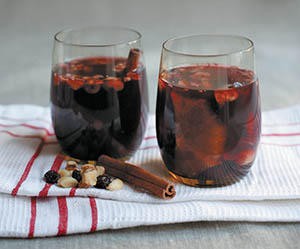

More than most Jewish Holidays, Chanukah is a festival celebrated by consuming traditional, regional foods—the very thought of the holiday can often make one salivate. For Jews of Russian/Lithuanian ancestry, the food of choice is potato latkes, for Polish Jews it’s ratzelech (latkes made with a mixture of potatoes and apples), for Italian Jews it’s fried chicken, and for Israelis it’s jelly doughnuts and mulled wine.
Mulled (i.e., heated and seasoned) wine has been drunk for millennia, and in the early days of the American republic, it was a popular wintertime tipple, along with mulled cider, mulled ale, and mulled rum. Today, while mulled wine may be almost as popular in the United States as driving an Edsel or a Yugo, in Israel it is rapidly becoming the drink of choice at Chanukah parties, and for good reason. In spite of its antiquated reputation and lack of popularity in America, mulled wine is tasty, inexpensive, easy to make and a great drink for Chanukah, or any other festive wintertime occasion.
So, in honor of Chanukah we provide you with three easy, tasty, recipes for making your own mulled wine.
Glögg (Israeli Chanukah Punch) (Serves 12)
It not exactly clear when or why this Swedish hot wine punch became so popular in Israel as a Chanukah drink, but today it is ubiquitous during the festival. There are probably hundreds, if not thousands, of good recipes for Glögg, but this is the one we use in the Kronemer household:
2 bottles of Bordeaux-style red wine (see note below)
1 tsp. Angostura Aromatic Bitters
2/3 cup brown sugar
1/4 tsp. cardamom seeds (removed from the pods)
2 whole cloves
6 allspice berries
½-inch piece of ginger, peeled and quartered
The zest of one small orange (make it a Seville orange if you can find one, and whatever orange you use, make sure to only remove the outer layer of the zest, leaving the white pith behind)
½ a cinnamon stick
1 cup blanched almond slivers
1 cup dark raisins
In a half-gallon mason jar, combine the wine, brown sugar and bitters. Wrap the ginger, zest and spices in a triple layer of cheesecloth, and seal with kitchen twine. Drop the spice packet into the jar, then seal the jar and give it a good shake. Let the jar sit in a cool, dark place for 10-12 hours, giving it a good shake every few hours. Then remove the spice packet and heat in a crockpot or chafing dish until almost simmering. To serve, put a handful of raisins and almond slivers in the bottom of each glass, then ladle in the hot punch.
English Bishop (serves five)
This sweet, Port wine-based drink dates to the 17th century, or perhaps earlier. The name, Bishop, is apparently a reference to the drink’s color, which is similar to the shade of purple found on an Anglican Bishop’s vestments.
1 bottle of Port wine (see note below)
1 medium-sized orange, densely studded with whole cloves
1 tbsp. brown sugar
6 tbsp. of Cognac (optional)
Nutmeg
Moisten the skin of the orange with 1 tbsp. of Cognac (or water), then dust the orange with the brown sugar. Roast or broil the orange until its skin has turned brown, and the sugar has caramelized. Quarter the orange and put it into a two-quart saucepan. Cover the orange quarters with the Port wine, then cover the saucepan and simmer for 20 minutes. To serve, mix in the remaining Cognac, ladle into glasses and garnish each glass with a little freshly grated nutmeg.
The Locomotive (serves 1)
This rich and satiny-smooth concoction was likely invented in the early 19th century, at about the same time as the vehicle for which it was named.
½ cup Bordeaux-style red wine (see note below)
1 tbsp. Senior’s Curacao or Cointreau
2 tbsp. honey
2 egg yolks, well beaten
Combine all the ingredients in a small saucepan, and stir until the honey is fully dissolved. Place the saucepan over a low flame and stir continuously until the mixture is about to start simmering. Remove the saucepan from the flame before it actually starts to simmer, and serve immediately.
Note on wine selection: One need not, and should not, mull expensive wines. Much of a wine’s nuance will be lost in the mulling process. For a Bordeaux-style red, Yarden’s Mount Hermon Red, Baron Herzog’s Merlot, Recanati’s Merlot, and Binyamina’s Yogev Cabernet Sauvignon/Merlot would all be good choices. For a Port wine, while a true Portuguese Port, such as Porto Corvordero or Porto Quevedo would be best, other less-expensive Ports, such as Kedem’s 50th Anniversary Port, should also work well.
Note on equipment. One should always make and serve mulled wine in non-reactive vessels. I like to mull wine in either earthenware, enamel-lined, or stainless-steel pots. Never mull wine in aluminum, as it can give the wine an off-putting metallic taste. I also find it best to serve mulled wine in those small, footed glass mugs known as either London dock glasses or Irish coffee glasses. The clear glass allows one to appreciate the color as well as the flavor of the drink.
By Gamliel Kronemer









